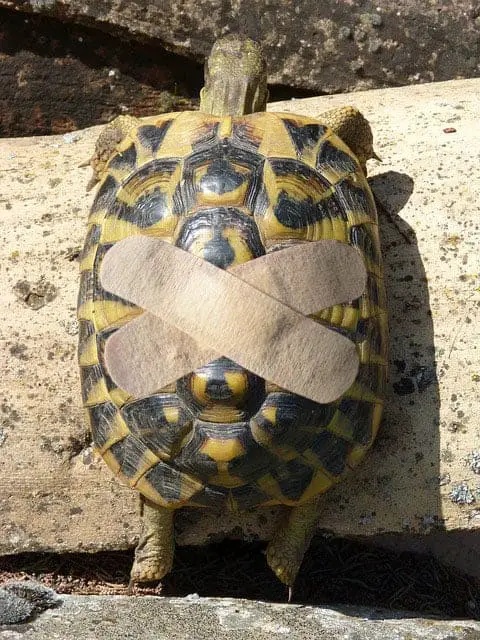
Tortoises need their shells like humans need their houses. Largely defenseless against predators, tortoises have evolved, and indeed thrived thanks to the presence of their shell. Without this feature it’s pretty safe to say that they would have died out long ago.
If a tortoise’s shell becomes injured for any reason it can be a very serious situation, particularly in the wild.

Birds are known to drop tortoises from great heights with the aim of breaking the shell to access the soft tissue inside, but of course the fall will kill the tortoise before it suffers this ultimate fate.
As this example demonstrates, it thankfully isn’t easy for a tortoise’s shell to become damaged, normally requiring the grit and tenacity of an appropriate flying predator to break. Indeed it is unlikely a tortoise could ever accidentally self inflict damage to their own shell.
The bigger risk is almost certainly due to predation, or more likely in a domestic setting, injuries from dog bites or lawn mower blades.
Should a tortoise’s shell become injured it is possible for it to heal, both naturally, or with assistance from temporary dressings, or permanent repairs made from fibreglass/epoxy, and in extreme circumstances, even steel bands.
For advice on tortoise injuries in general, see this article.
Can a Tortoise Survive With a Cracked or Damaged Shell?
The biggest threat following most cases of a cracked or damaged shell, in the short term at least, is infection to the wound site.
After all, being an external section of the tortoise’s skeleton means that by definition if the shell is damaged it will often expose the tortoise’s soft and vulnerable inner tissue.
The good news is that where a wild tortoise may not fare so well, a tortoise in captivity can be readily treated both for the injury to the shell itself, and for any infections that manifest as a result.
Certain injuries to the shell are actually quite common, especially the point nearest to the tail. This area is often damaged when two males fight, or during mating.
This type of injury may chip away at the external scutes, leaving the bone underneath exposed. Usually this doesn’t require any treatment besides keeping the area clean, although you should keep an eye out for any possible signs of infection such as discharge.
More serious injuries such as shell crushing as a result of a fall or laceration from a lawn mower blade will clearly need further attention.
Lung Injury
One of the more alarming secondary injuries resulting from a broken shell is a punctured lung. This will be apparent by a frothy, bloody discharge emerging from the wound as the tortoise breathes.
Whilst in mammals such an injury would be considered very serious because of the risk of lung collapse and respiratory failure, in tortoises this is thankfully less of an issue, and in many cases the tortoise will still be able to breathe despite such a wound.
Treating a punctured lung is however a little more problematic from a washing/disinfecting perspective, as there is a risk of introducing fluid into the lungs.
Nonetheless a vet who is qualified to treat tortoises will be adept at managing such wounds, but this highlights the importance of getting specialist help.
How Long Does it Take For a Shell to Heal?
It takes about 12 weeks for a properly managed shell wound to heal properly. While you might expect a more severe fracture to take longer to heal, ostensibly this is not the case.
None the less smaller fractures are still far easier to manage; requiring less dressing and, with less chance of infection setting in.
How Can You Fix a Tortoise Shell?
As mentioned above, preventing infection is a large part of the battle with shell injuries, so in theory you could treat a broken shell with antiseptic, and antibiotic treatment alone, and given time the shell would heal of its own accord.
However theory and practice are often uncomfortable bedfellows, and this is certainly the case here. The reality is that it will be near impossible to keep an open wound clean and disinfected for long enough whilst the shell heals.
It may be many months before sufficient healing has taken place, so other interventions are required besides medications and disinfectant.
For smaller cracks it may be sufficient for a vet to apply a temporary dressing similar to the plaster cast placed on a broken human limb.
For more substantial cracks a more permanent solution may be required. The vet will use their best judgement, but most commonly a medical grade epoxy resin will be used to bond the two exposed halves of the crack back together.
It may be necessary for some sort of ‘bridging piece’ to be used to add additional strength to the join.
The major risk involved when applying either a temporary or permanent fixture to the shell is the possibility of trapping infection within the wound, which could actually do more harm than good.
The vet will therefore want to be sure that wound has healed sufficiently prior to covering it up, potentially for good.

